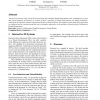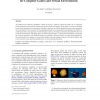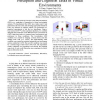VR
2002
IEEE
13 years 11 months ago
2002
IEEE
Much of the current research in the design of virtual environments is centred on laboratory prototypes and emphasis is placed on supporting cooperation within the virtual world its...
PRESENCE
2002
13 years 11 months ago
2002
A set of rules is presented for the design of interfaces that allow virtual objects to be manipulated in 3D virtual environments (VEs). The rules differ from other interaction tec...
PRESENCE
1998
13 years 11 months ago
1998
Virtual environments are envisioned as being systems that will enhance the communication between humans and computers. If virtual systems are to be effective and well received by ...
PRESENCE
1998
13 years 11 months ago
1998
Two experiments investigated components of participants’ spatial knowledge when they navigated large-scale ‘‘virtual buildings’’ using ‘‘desk-top’’ (i.e., nonimm...
FGCS
1998
13 years 11 months ago
1998
Scientists can gain much more insight from their simulations if they are enabled to change simulation parameters on the y while observing the results immediately. A crucial aspect...
SAJ
2000
13 years 11 months ago
2000
Presence has become a key concept in characterizing and evaluating Virtual Environments. Our contribution is to show that current measures of Presence, as a metric of users' ...
AAI
2000
13 years 11 months ago
2000
Reearch into virtual environments on the one hand and artificial intelligence and artificial life on the other has largely been carried out by two different groups of people with ...
AAI
2000
13 years 11 months ago
2000
: As Virtual Environments applications become more complex, there is a need to interpret user interaction in terms of high-level concepts. In this paper, we investigate the relatio...
CGF
2005
13 years 11 months ago
2005
As simulation and rendering capabilities continue to increase, volumetric effects like smoke, fire or explosions will be frequently encountered in computer games and virtual envir...
IJVR
2007
13 years 11 months ago
2007
—We propose the concept of Gap Between Displays (GBD) as a component of immersion in virtual environment systems. We hypothesized that GBD may reduce users’ task performance in...






